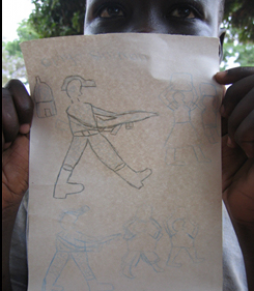NetSquared just announced the top ten projects in UCB Human Rights Center Mobile Challenge, as chosen by community vote. The challenge, which was open to any project using mobile technology to support human rights work, had over fifty entrants from a wide spectrum of human rights organisations, technical experts and issue-based groups. Three winners will be announced at the Soul of the New Machine conference in May.
Competitions aside, there are some excellent ideas both in the project gallery and in the top ten shortlist. It's also clear that many of the ideas cluster around one or other recurring theme. Mobiles and surveillance, the subject of a previous MobileActive primer, is one such theme, and there were a number of projects attempting to address the threat of intercepted communication. Guardian: Secure, Private Telephone Built on Google Android aims to build an open source android-based smartphone distribution, with operating system components, libraries and applications to support secure and private mobile browsing, instant messaging (IM), SMS and voice-over-IP (VOIP) calls. The distribution also aims to support encrypted data and contacts storage, contact key management and a remote destruction 'poison pill' function. Guardian will work with existing standards, such as off-the-record messaging for secure IM, and existing open source projects, such as TOR and Psiphon for anonymous browsing, to bring established security and privacy applications to the Android platform.
Guardian is an ambitious project, and not something we can expect to see in widespread use until Google Android is more widely supported by smartphone hardware. At the same time, that this kind of project is possible is testament to the huge gain that Android as an open source operating system represents for the mobile space. There's also a promising business model for secure multi-mode mobile communications because of its value to commercial players, who, in contributing to or funding an open source secure phone project, would effectively be cross-subsidizing software development for activist groups.
A second group of projects looked at mobiles as tools to capture and report evidence of human rights violations. The shortlisted Digital Democracy's Handheld Human Rights project has chosen to focus on how mobiles can extend the observer networks of advocacy groups. By creating a platform whereby any phone can be used to report instances of abuse, everyone becomes a potential witness, and every phone a potential communication node in a grassroots observer network. Issue-based and regional variations on this theme were also found in other projects. HarassMap , which hopes to use SMS to help women report sexual harassment on the street in Egypt, while Live a life alerts observers to incidents of human trafficking in India and Nepal.
The multimedia recording capability of phones also provides a chance to capture evidence in high-impact formats. Still images, videos and audio clips can communicate an emotive, evocative message, and such types of multimedia evidence can be used to great effect in human rights and advocacy work.
Another shortlisted project, Spreading it: Received by Everyone, adds an additional step to the mobile incident reporting concept. The project's proposers consider mobiles as channel for disseminating reports to advocacy groups, using the example of an incident report reaching an advocacy group just in time for it be used to illustrate the issue in a crucial meeting. This project also recognises the multimedia recording capability of phones, which provides a chance to capture evidence in high-impact formats. Often, still images, videos and audio clips are valuable not only as evidence, but also in future awareness-raising and advocacy activities.
It's worth mentioning the privacy and information ethics implications of mobile incident reporting systems and databases. Where the perpetrator of human rights violations is able to gain the cooperation of mobile operators, surveillance is a constant threat. Several projects proposed voice-based data collection systems, which could be used to identify and target people calling in. Use of a plain-text transmission formats such as SMS under these conditions is even less desirable, and any transmission of data over the mobile network should be properly encrypted. Even after the immediate incident has passed, care should be taken to remove all potentially identifiable data from incident reports before making them available to advocacy groups, or to the public. Recent revlations about the extremely poor protection of indivduals' data in British government databases again emphasise the need for clearly delineated, competantly implemented, non-negotiable data protection policies
There are many other exciting projects in the HRC-UCB project gallery. Many of the ideas that didn't make top ten list other possible sources of funding, and hopefully we'll see some of them being implemented too. A few more are innovative but not really specific to the human rights domain, and perhaps would be better targeted to more general applications (two of these are The “It's Real” Project: Mobile authentication of human rights evidence, title, patent, copyright, and contract documentation and Fluid Nexus: Mobile Messaging without the Mobile Phone Network ). All in all though, the project gallery is inspiring, and a showcase of the potential for mobiles in human rights work. Go and take a look!
Disclosure: MobileActive's Katrin Verclas was a judge for the Challenge.
Photo Courtesy: University of California Berkeley Human Rights Center


Post new comment